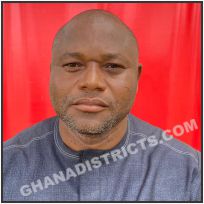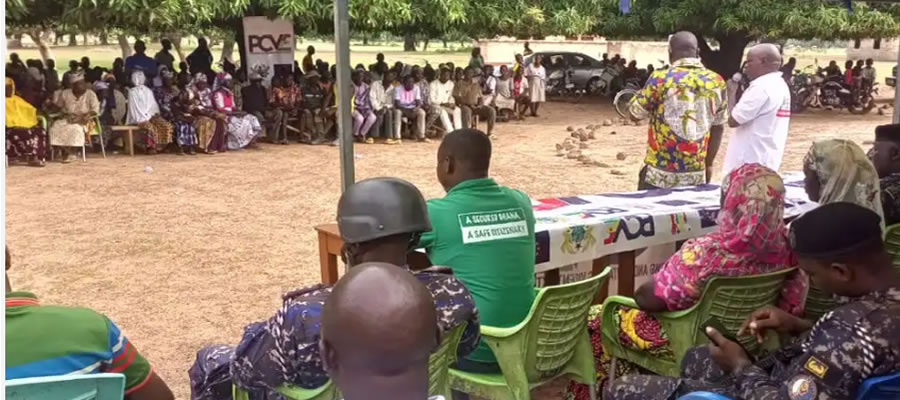

POPULATION AND SETTLEMENT STRUCTURE.
Growth and size.
The 2010 population and housing census gave a District Population of 130,003. The male population in the District is 62,025 representing 47.7 percent of total population while that of the female population is 67,978 also representing 52.3 percent. An exponential projection using the district growth rate of 1.37% gives a figure of 135,467 disaggregated into 64,632 male and 70,835 female as the 2013 population and is expected to be 143,111 thus 68,279 male and 74,832 female by 2017.
Population Structure
The sex ratio rises gradually from the 0-4 age group (91.2) through to the 15-19 age groups (115.1). The ratio however drops to 95.2 at the 20-24 age groups but rises again from 67.5 for age group of 65-69 to 113.6 for age group of 95-99. This development could be as a result of outmigration for most males who travel to the Southern part of Ghana in search of job opportunities. These people however return home when they go on retirement or are too old to work.
This implies that a huge requirement for educational infrastructure and other human resource development programmes so as to build a good future for the youth and prevent problems associated with youth unemployment. Currently there is a growing incidence of child trafficking condoned by parents or relatives who apparently cannot cater for these children.
A Substantial number of the District’s population is under 15 years of age which implies a stress on the working population. The age-dependency ratio is the ratio of persons in the dependent ages (generally under age 15 and over age 64) to those in the economically productive ages (15-64 years) in the population.
This development implies that the number of persons in the active age group (15-64) is lower vis-a-vis those in the dependent group. This means that there are approximately 117 persons in the dependant ages for every 100 persons in the working ages. This relationship however does not translate into economic dependency since some of the people in the 0-14 and 65+ could be working while some of those in the 15-64 may not.
Household Size, Family System and Gender
Household sizes in Garu-Tempane District are fairly large. According to the 2010 population Census report, there were 13,383 houses in the census year made up of 17,520 households. On the average there were 7 persons per household.
The society is generally patrilineal and traditionally male dominated. Out of the total number of households only 16.3% were female headed whiles the remaining 83.7% were male headed. Children born to couples, traditionally form part of the man’s extended family.
Women are not only generally less active in decision-making, but are also traditionally not allow to own land, responsible for the bulk of the household activities such as planting, weeding, harvesting and selling, as well as such chores as cooking and fetching water.
This makes gender considerations very important for planning in general. In decision making, women are only actively involved in the management and maintenance of water facilities such as pumps and boreholes, because they are the direct operators.
It is however important to extend gender beyond this to include decision making at the home and governance institutions such as the local government system.
The population density of Garu-Tempane District is 99 persons per sq. km.
Below is a population pyramid.
The population pyramid depicts a high population of the youth and with agriculture as the main economic activity in the District there would be pressure on the land. There is the need diversify, educate and provide alternative livelihood for the youth.
Migration
The 2010 population and housing census sought information on place of birth in relation to locality of enumeration. Birthplace and migratory pattern are, therefore, analysed by comparing locality of birth with locality of enumeration. Persons born in the locality of enumeration are assumed not to have had any migratory history. This may not necessarily be the case since some people who might have moved outside their locality of birth could have returned to that locality for the census or on visit or on retirement.
Their migratory moves would thus be lost. Birthplace in relation to place of enumeration is, therefore, only a crude measure of migration. The information is restricted to Ghanaians by birth and therefore does not capture the true volume of movement into the District.
Table 9.1 shows the birthplace by duration of residence of migrant. A total of 6,123 people in the district were born outside the district. This figure is considered as the total migrants in the district as at the reference period. Those born elsewhere in the Upper East Region constitute 38.0 percent.
About 51.8 percent were born elsewhere in another region in Ghana whilst 17.4 percent were born outside Ghana. Of those born elsewhere in another region in Ghana, majority (67.3%) were born in the Ashanti Region and of this group, most (31.1%) stayed there between 1-4years. Also, of those born in the in the Upper East Region, the majority (40.9%) lived there for 20 or more years and the least (8.7%) staying between 5-9 years. About 40.9 percent of those born outside Ghana lived there for about 20 years or more.
Though people of diverse ethnic and religious backgrounds inhabit the District communal spirit is high. All the religious denominations encourages full participation of both men and women in development activities. Because of large numbers of women in the District they seem to dominate in all religious groups.
There however seem to be no institutional mechanisms to ensure inter religious dialogue to promote peaceful co-existence of religious diversity. This is a development challenge that need to be tackled.
Date Created : 11/20/2017 6:26:28 AM











 facebook
facebook
 twitter
twitter
 Youtube
Youtube
 +233 593 831 280
+233 593 831 280 0800 430 430
0800 430 430 GPS: GE-231-4383
GPS: GE-231-4383 info@ghanadistricts.com
info@ghanadistricts.com Box GP1044, Accra, Ghana
Box GP1044, Accra, Ghana